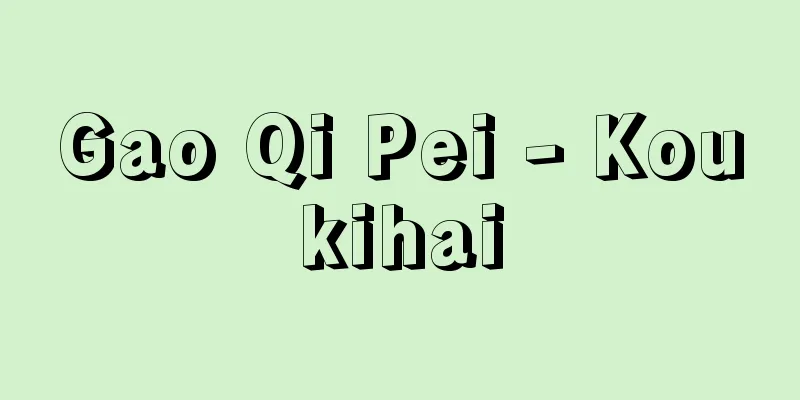Onjoji Temple

|
Located in Onjoji-cho, Otsu City, this temple is the head temple of the Tendai sect of Buddhism, Jimon sect. It is commonly known as Miidera. Hieizan Enryakuji is called Sanmon, whereas this temple is called Teramon. Its mountain name is Nagarasan. It is said that Otomo no Yota no Otomo donated his rural castle to build this temple on Nagarasan at the request of the three emperors Tenchi, Kobun, and Tenmu, and named it Nagarasan Onjoji. Old roofing tiles from the Hakuho period have been excavated, so it is said that it may have been built as the family temple of the Otomo clan during that period. It is said that the temple was called Mii-dera Temple because the spring where the three emperors Tenchi, Tenmu, and Jito were born was located within the temple grounds, or that Enchin (Chisho Daishi) used the water from the sacred spring as the water for the three-part ablution ceremony, and that it was named Mii-dera Temple because it awaits the dawn of the Maitreya San-e ceremony, when Maitreya Bodhisattva descends to this world and saves people. It is also said that in 858 (Ten'an 2), when Enchin returned from China, Silla Myojin appeared to him, and he accompanied Enchin to Mii-dera Temple as it would be a good place to store the sacred books that would be collected in the future. He was welcomed by a 162-year-old monk named Kyotai, and Totomumaro, the son of Otomo no Yota no O, donated the temple to Enchin. In the Tendai sect, the Jikaku Daishi (Ennin) line and the Chisho Daishi line were practiced side by side, and head priests came from both sects, but in the mid-Heian period, the Jikaku Daishi line refused Yokei, who was appointed head priest, and the conflict between the two sects became more intense. Finally, in 993 (Shoreki 4), monks from the Chisho Daishi line entered Onjo-ji Temple, and the temple split into two factions: the Jikaku Daishi lineage at Mount Hiei and the Chisho Daishi lineage at Onjo-ji Temple. With the rampant monk soldiers, they burned down the temple and fought each other, leading to Onjo-ji Temple being burned down four times during the Heian period. In addition, the temple's buildings were burned down because it allied with the Minamoto clan and cooperated with the anti-Taira clan movement led by Emperor Goshirakawa, but it was restored under the protection of Minamoto no Yoritomo and others. The Chisho Daishi sect tried to establish a new ordination platform at Onjo-ji Temple in order to allow monks of the temple lineage to receive the precepts, but they fought with the Sanmon sect. They also approached the Ashikaga clan, and the temple was burned down many times by the Kitabatake and Nitta clans. In 1595 (4th year of Bunroku), Toyotomi Hideyoshi angered the temple, destroying it and confiscating its land, but it was later allowed to be rebuilt, and in the Edo period there were 59 temples in three towers in the north, middle, and south, and 25 temples in five auxiliary temples. It has Enman-in, Shogo-in, and Jisso-in as monzeki temples, and is considered one of the four great temples in the Kyoto region, along with Todai-ji, Enryaku-ji, and Kofuku-ji. [Tamura Kosuke] Annual EventsThe Kishimojin Festival is held at the Shinra Zenshindo Hall every year on May 16th, and is also called Sendango because rice dumplings are offered to the altar to pray for the growth of children. In addition, Fudayaki is held on the second Saturday of July, and Sennichie for Kannon Bodhisattva is held on August 9th. [Tamura Kosuke] Temple treasuresAmong the structures are the Onjo-ji Golden Hall, which was completed in 1599 (Keicho 4) by Hideyoshi's Kita no Mandokoro, the Kan'gakuin Guest Hall, which was completed the following year, and the Kojo-in Guest Hall, which was completed the year after that (all national treasures), and are considered representative architecture of the Momoyama period. One of the guardian deities of Onjo-ji is the Silla Zenshin-do Hall (national treasure), which enshrines Silla Myojin, and is a representative example of the Nagare-zukuri style shrine buildings common in Shiga Prefecture. Other buildings designated as Important Cultural Properties include the Toin, Akaya, bell tower, Issaikyozo, Daimon, three-story pagoda, and Jikido. Paintings and documents include the Heian period calligraphy Gobu Shinkan and the 51-volume, two-fold book of documents related to Chisho Daishi, both of which are national treasures. There is also a statue of Acala (yellow Acala, national treasure) that is said to have been seen by Enchin during zazen (zazen), and it is considered one of the three great Acala statues, along with the red Acala at Mt. Koya and the blue Acala at Shoren-in. As for sculptures, there are two wooden seated statues of Chisho Daishi and one seated statue of Silla Myojin, both of which are national treasures. There are also many other temple treasures designated as important national cultural properties. There are four bells at Onjoji Temple, of which the Great Bell from Keicho is famous as the "Mitsui Evening Bell." There is also a legend that Benkei stole the "Benkei's Hikizuri Bell," but as it rang "inou" (want to go home), he dropped it into the valley. In reality, it was stolen by a mountain priest in 1264 (Bun'ei 1), and was returned three years later by order of the shogunate. The temple grounds include the tomb of Emperor Kobun and the grave of Fenollosa, a researcher of ancient Japanese art. The Nyoirin Kannon Bodhisattva on the mountain in Minami-in, known as the 14th temple of the Thirty-Three Temples of the Western Provinces, is famous as a pilgrimage Kannon. [Tamura Kosuke] “Japanese Tendai History” written by Fumihide Uesugi (1936, Hajinkaku Shobo) ▽ “Reprint of “Onjoji no Kenkyu” edited by the Tendai Sect Temple School Gokankyo Secretariat (1978, Shibunkaku Publishing)” Kondo (national treasure). Otsu City, Shiga Prefecture © Lake Biwa Visitors Bureau Onjoji Temple (Mii-dera Temple) Nationally designated important cultural property Otsu City, Shiga Prefecture © Lake Biwa Visitors Bureau Public Interest Incorporated Association "> Bell tower of Onjoji Temple (Mii-dera Temple) Version by Eikichi Uoya (Uoei) ( Owned by the National Diet Library ) Hiroshige Utagawa's "Eight Views of Omi: The Evening Bell at Mitsui" 1854 (Ansei 1) Edition by Moriya Jihei (Moriji) National Diet Library Utagawa Fusatane "Eight Views of Omi: The Evening Bell of Mitsui" Source: Shogakukan Encyclopedia Nipponica About Encyclopedia Nipponica Information | Legend |
|
大津市園城寺町にある天台宗寺門(じもん)派の総本山。通称三井寺(みいでら)。比叡山(ひえいざん)延暦寺(えんりゃくじ)を山門というのに対し、寺門と称する。山号は長等山(ながらさん)。天智(てんじ)、弘文(こうぶん)、天武(てんむ)の3天皇の勅願により大友与多(よた)王が田園城邑(じょうゆう)を投じて長等山に建立、長等山園城寺と称したと伝えられる。白鳳(はくほう)時代の古瓦(こがわら)が出土するので、その時代に大友氏の氏寺として建てられたものではないかともいわれる。境内に天智、天武、持統(じとう)3帝の誕生水があったので、御井(みい)の寺といわれたとも、円珍(えんちん)(智証(ちしょう)大師)が霊泉の水を三部灌頂(かんじょう)の法水に用い、弥勒菩薩(みろくぼさつ)がこの世に下り、人々を救済するという弥勒三会(さんえ)の暁を待つ意味で三井寺とよばれたともいう。また、858年(天安2)に唐から帰国した円珍のもとに、新羅明神(しんらみょうじん)が姿を現し、将来した典籍を収めるによい場所として三井寺へ円珍を伴うと、162歳の教待(きょうたい)という老僧が迎え、大友与多王の子都堵牟麿(ととむまろ)が寺を円珍に献じたと伝えられている。 天台宗では慈覚(じかく)大師(円仁(えんにん))系と智証大師系が並び行われ、両派から座主(ざす)が出ていたが、平安時代中期、座主に任ぜられた余慶(よけい)を慈覚大師系が拒否して両派の抗争が盛んとなった。ついに993年(正暦4)智証大師系の僧は園城寺へ入り、比叡山の慈覚大師系の山門と、園城寺の智証大師系の寺門の両派に分裂し、僧兵の跋扈(ばっこ)もあって互いに焼き打ちをしたりして争ったため、園城寺は平安時代に四度焼かれている。また、源氏と結び付いて後白河(ごしらかわ)法皇などの反平氏運動に協力したために堂舎を焼かれたが、源頼朝(よりとも)以下の保護を受けて再興した。智証大師派は寺門系の僧を受戒させるため、園城寺にも戒壇を新設しようとして山門と争い、また足利(あしかが)氏に近づいて北畠(きたばたけ)氏、新田(にった)氏に焼かれるなど、何度も焼かれている。1595年(文禄4)に豊臣(とよとみ)秀吉の怒りに触れて寺は壊され、寺領を没収されたが、のちに復興が許され、江戸時代には、北院・中院・南院の3塔に59院、5別所に25坊があった。門跡(もんぜき)寺院として円満(えんまん)院、聖護(しょうご)院、実相(じっそう)院をもち、東大寺、延暦寺、興福寺とともに京畿(けいき)の四大寺の一とされている。 [田村晃祐] 年中行事毎年5月16日に新羅善神(しんらぜんしん)堂で鬼子母神(きしもじん)祭が行われるが、子供の成長を祈って団子を神前に供えるので千団子ともいわれる。また、7月第2土曜日に札焼(ふだやき)、8月9日に観音菩薩(かんのんぼさつ)の千日会(せんにちえ)が行われる。 [田村晃祐] 寺宝建造物では、秀吉の北政所(きたのまんどころ)によって1599年(慶長4)竣功(しゅんこう)した園城寺金堂、翌年竣功の勧学院客殿、翌々年竣功の光浄院客殿(以上国宝)があり、桃山時代の代表的建築とされている。園城寺の鎮守の一つで、新羅明神を祀(まつ)る新羅善神堂(国宝)は、滋賀県に多い流造(ながれづくり)社殿の代表的なものである。そのほか唐院、閼伽井(あかい)屋、鐘楼、一切経蔵(いっさいきょうぞう)、大門、三重塔、食堂(じきどう)などが国重要文化財に指定されている。絵画、文書には、国宝として平安時代書写の図像「五部心観(ごぶしんかん)」や智証大師関係文書典籍51巻夾2帖(じょう)がある。また円珍が坐禅(ざぜん)中に感見したと伝えられる不動明王画像(黄不動、国宝)があり高野山(こうやさん)の赤不動、青蓮(しょうれん)院の青不動とともに、三大不動明王像の一つとされる。彫刻では、木像智証大師坐像(ざぞう)2躯(く)、新羅明神坐像1躯が国宝。そのほか国重要文化財指定の寺宝が多い。 園城寺には四つの鐘があり、そのうち慶長(けいちょう)の大鐘はいわゆる「三井の晩鐘」として名高い。また「弁慶(べんけい)の引摺(ひきずり)鐘」は、弁慶が奪ったが、「いのう」(帰りたい)と鳴るので谷底へけ落としたという伝説をもつ。実際には、1264年(文永1)に山法師に奪われ、3年後に幕府の命によって返却されたものである。寺域には弘文天皇御陵、日本古美術の研究者フェノロサの墓がある。なお、西国三十三所第14番札所として知られる南院の山上の如意輪(にょいりん)観音は巡礼観音として名高い。 [田村晃祐] 『上杉文秀著『日本天台史』(1936・破塵閣書房)』▽『天台宗寺門派御遠忌事務局編『園城寺之研究』再版(1978・思文閣出版)』 金堂(国宝)。滋賀県大津市©公益社団法人びわこビジターズビューロー"> 園城寺(三井寺) 国指定重要文化財 滋賀県大津市©公益社団法人びわこビジターズビューロー"> 園城寺(三井寺)鐘楼 魚屋栄吉(魚栄)版国立国会図書館所蔵"> 歌川広重『近江八景 三井晩鐘』 1854年(安政1) 森屋治兵衛(森治)版国立国会図書館所蔵"> 歌川房種『近江八景 三井晩鐘』 出典 小学館 日本大百科全書(ニッポニカ)日本大百科全書(ニッポニカ)について 情報 | 凡例 |
Recommend
Ikenobo Senjo - Ikenobo Senjo
1769-1832 A flower arranger from the late Edo per...
Cyclotron resonance
Charged particles perform cyclotron motion (circul...
The twelve imperial sen coins
A general term for the 12 types of copper coins i...
"Kusharon" - Kusharon
…Sanskrit name: Abhidharmakośabhāṣya. Abbreviated...
Yoruba people - Yoruba (English spelling)
An ethnic group scattered across southwestern Nige...
Miyafuda - Kyuboden
During the Joseon Dynasty in Korea, fields were se...
《Robert the Devil》
…In 1816, he went to Italy, where he performed op...
Oncidium flexusosum - Oncidium flexusosum
...About 500 species are distributed from the Wes...
Calandrella
... The Melanocorhynchus genus, found mainly in A...
Iranian mythology - Iranian mythology
[origin] In ancient times, people who spoke langu...
venation
…The veins that create various patterns on the le...
alignment
...This corresponds to the fact that the spins ar...
Shigemasa Iwakura
...Later, it was passed down to Mitajiri (Yamaguc...
Apoenzyme
…It is well known today that differences in the p...
Political system
A theoretical model that treats political phenomen...









